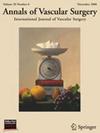Long-Term Volumetric Evaluation of Stent-Assisted Balloon-Induced Intimal Disruption and Relamination of Aortic Dissection (STABILISE) in Acute Type B Aortic Dissection
IF 1.4
4区 医学
Q3 PERIPHERAL VASCULAR DISEASE
引用次数: 0
Abstract
Background
To quantify the volumetric aortic remodeling of patients with acute type B aortic dissection treated with the stent-assisted balloon-induced intimal disruption and relamination (STABILISE) technique.
Methods
All patients with acute type B aortic dissection operated with the STABILISE technique between 2014 and 2017 with preoperative, postoperative, and >12 months (follow-up) computed tomography scans were included in this study. True lumen and total aortic volume were accurately assessed in the thoracic and abdominal portions with a semiautomatic three-dimensional tool. Associations with long-term adverse events were estimated.
Results
Seventeen patients were measured at preoperative, postoperative, and a mean follow-up of 19 ± 8 months. The false lumen to total volume ratio decreased on average from 63% to 18% after STABILISE (P < 0.001) and remained around 12% at follow-up. These remodeling was more pronounced in the thoracic aorta (7%) than in the abdominal aorta (28%). The trend in aortic size growth was stronger for volumes than for maximum areas or diameters (P < 0.001, P < 0.05, and P < 0.05, respectively). Adverse events were identified in 4 patients during a long-term follow-up of 76 ± 18 months. The only aortic size variable assessed preoperatively that was associated with undesirable events was the total volume of the abdominal aorta (P < 0.05).
Conclusions
A volumetric analysis of dissected aortic size after the STABILISE procedure allowed accurate quantification of mid-term aortic remodeling and helped to identify the abdominal aortic volume as a preoperative variable associated with undesirable long-term events.
对急性 B 型主动脉夹层(STABILISE)进行支架辅助球囊诱导内膜破坏和主动脉夹层复层的长期容积评估。
目的量化接受支架辅助球囊诱导内膜破坏和重塑(STABILISE)技术治疗的急性B型主动脉夹层(ATBAD)患者的主动脉容积重塑情况:本研究纳入了2014年至2017年期间所有采用STABILISE技术进行手术的ATBAD患者,并对其进行了术前(PreOp)、术后(PostOp)和>12个月(随访)的计算机断层扫描。使用半自动三维工具准确评估了胸腔和腹腔部分的真腔和主动脉总容积。结果:结果:17 名患者在手术前、手术后和平均 19±8 个月的随访中接受了测量。STABILISE术后,假腔与总容积之比平均从63%降至18%(p结论:在 STABILISE 手术后对剖开的主动脉大小进行容积分析,可准确量化中期主动脉重塑情况,并有助于确定腹主动脉容积是与不良长期事件相关的术前变量。
本文章由计算机程序翻译,如有差异,请以英文原文为准。
求助全文
约1分钟内获得全文
求助全文
来源期刊
CiteScore
3.00
自引率
13.30%
发文量
603
审稿时长
50 days
期刊介绍:
Annals of Vascular Surgery, published eight times a year, invites original manuscripts reporting clinical and experimental work in vascular surgery for peer review. Articles may be submitted for the following sections of the journal:
Clinical Research (reports of clinical series, new drug or medical device trials)
Basic Science Research (new investigations, experimental work)
Case Reports (reports on a limited series of patients)
General Reviews (scholarly review of the existing literature on a relevant topic)
Developments in Endovascular and Endoscopic Surgery
Selected Techniques (technical maneuvers)
Historical Notes (interesting vignettes from the early days of vascular surgery)
Editorials/Correspondence

 求助内容:
求助内容: 应助结果提醒方式:
应助结果提醒方式:


